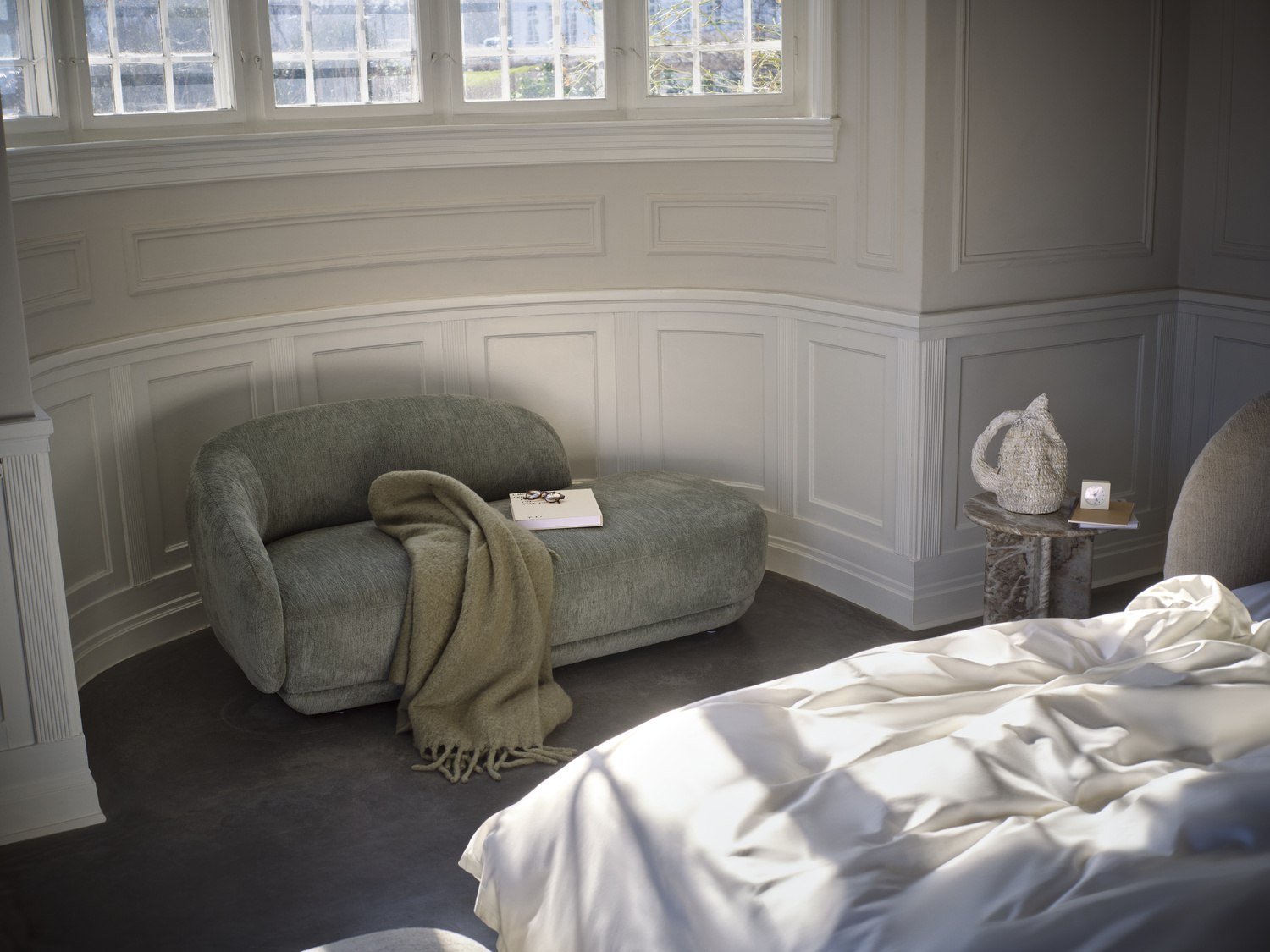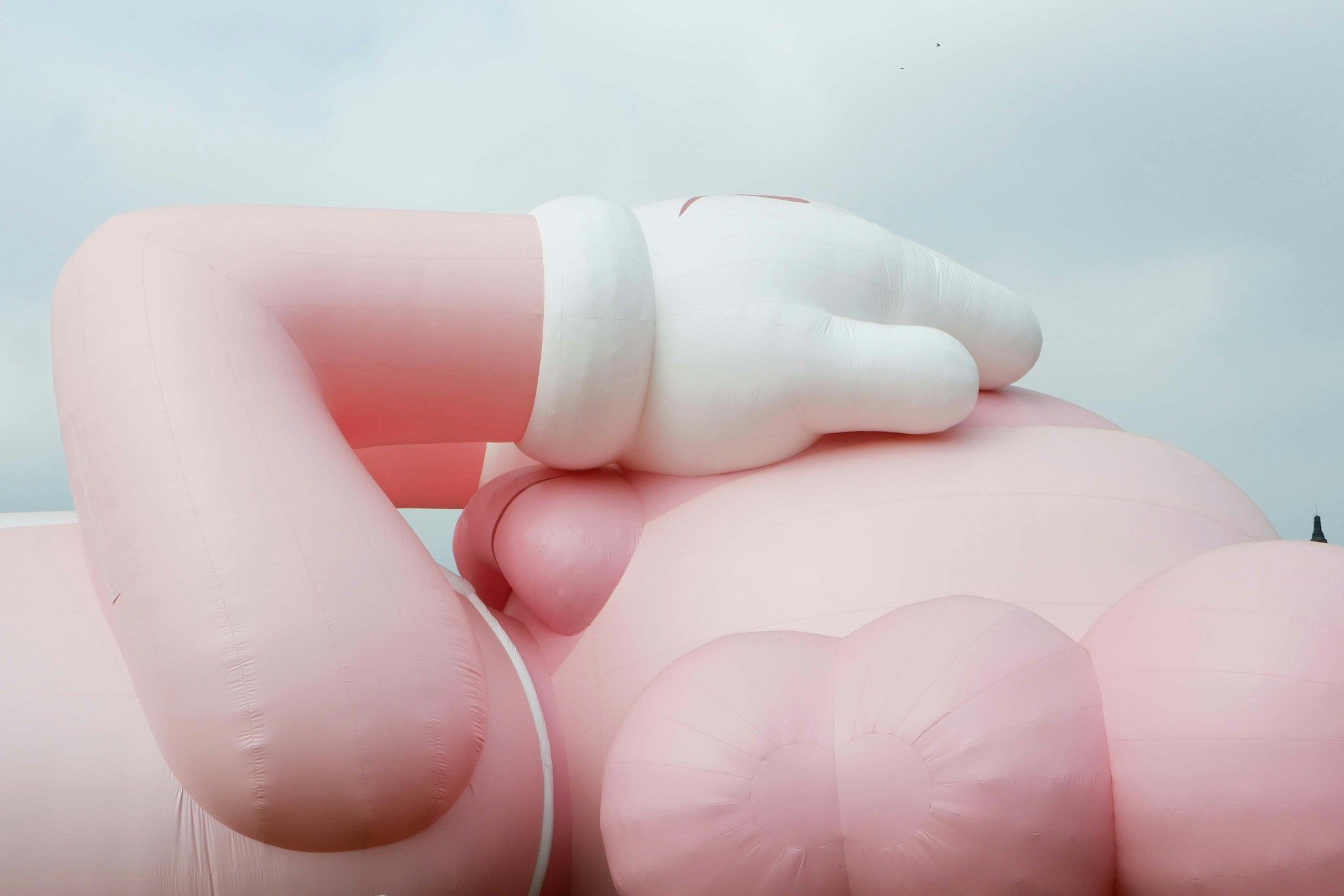The New York Botanical Garden (NYBG) has announced an unexpected but telling combination of pop culture and nature: in spring 2027, the internationally famed artist KAWS (Brian Donnelly) will stage a “garden-wide takeover” of the 250-acre Bronx site. Enormous, X-eyed sculptures of KAWS’s signature characters will appear amid the living landscapes, turning the garden itself into a living canvas. This announcement, following a summer Orchid Show tribute to New York City and an upcoming “Flower Power” exhibition celebrating flowers as symbols of peace, reinforces the NYBG’s mission: “at the intersection of ecology, design, and the arts.” What might a KAWS show in a botanical setting mean, and how does his brightly coloured yet melancholic imagery resonate amid plants and flowers? To answer this, we must first understand KAWS’s visual language and themes, as well as why a floral backdrop offers a new perspective on his work.
KAWS’s art revolves around a cast of cartoonish characters, most famously COMPANION, a Mickey-Mouse-like figure with X’d-out eyes, that carries equal measures of innocence and melancholy. These figures are part-human, part-cartoon, often reclining or cradling one another as if in repose or sorrow. In one sculpture (COMPANION 2020), the character lies face down with arms at its sides, its bulbous “Mickey-feet” extended and laces spilled down. The effect is uncanny: a children’s cartoon hero posed in a pose of profound despondency. As the Carnegie Museum’s Justin Hopper observes, Companion “carries the signifiers of a children’s cartoon character while emoting more somber human feelings”. Such images invite multiple readings: relief or hopelessness, innocence or death.
KAWS himself has described this blend of cute and dark as central to his work. He was inspired by Andy Warhol’s freewheeling pop sensibility and the urgency of 1960s comic art (Keith Haring and Basquiat also influenced him). Yet, he embeds an unease beneath his bright surfaces. The curator Eugenie Tsai notes that love, friendship, isolation, and loneliness are “symbols of our time,” making KAWS’s work “more relevant than ever“. In KAWS’s world, even playthings have a shadow side. His characters’ X’d-out eyes (a visual motif he shares with Warhol and pop culture) signal exhaustion or death; a Companion figure carrying a broken Sesame Street doll in one work (GONE) feels like a mute elegy to childhood loss. KAWS’s language of big-eyed cartoons is a form of pop pessimism, characterized by candy-colored shapes charged with the anxiety and isolation of the modern condition.
KAWS’s figures often evoke a sense of both comfort and unease, like companionable ghosts. In KAWS’s sculptures and toys, the familiar forms of Mickey Mouse or SpongeBob are reimagined with skull-like heads and X-shaped eyes. Viewers see a friendly outline, but it carries a sting of loss or loneliness. This tension – between nostalgia and unease, mass culture and melancholy – is KAWS’s signature. Each oversized Companion or mutated cartoon invites us to reflect: this is playful whimsy, yes, but also an elegy for the age in which we live.
KAWS’s iconography is designed to be repeatable and collectible. He started his career in the 1990s on the streets of New York (and New Jersey) as a graffiti artist. Working under the name KAWS (a graffiti tag), he subverted commercial images — stenciling or “ad-busting” popular ads on buses and billboards, much like Haring and Basquiat before him. From these roots, he developed a franchise of art: Companion, along with characters like CHUM, BENDY, and later ACCOMPLICE, became his trademarks. These figures appear across every medium he touches – from street murals to canvas paintings, vinyl toys, T-shirts, album covers, and fashion collaborations. KAWS has turned ‘merchandise’ into art. He is “equally adept at exhibiting in major international galleries” and selling Companion plush toys or General Mills cereal boxes emblazoned with his skull-and-crossbones skull head. His career has traced a path from underground artist to global phenomenon: today, he has millions of social media followers and collaborates with brands like Dior, Uniqlo, and Disney, blurring the lines between high art and consumer culture.
Yet this fame is double-edged. While KAWS has sold pieces at auction for millions and staged museum retrospectives (for example, KAWS: WHAT PARTY at the Brooklyn Museum in 2019), he remains a polarizing figure. Traditional art critics sometimes dismiss his popular collabs and merchandise as vacuous, just as Warhol was once derided for soup cans. However, defenders argue that KAWS’s work cannot be reduced to a “shallow celebration of capital.” Indeed, as Carnegie’s exhibition on KAWS paired him with Warhol, it revealed a shared depth: both artists “offer up images that are candy-colored” with pop resonance, yet “have a secondary meaning that’s more critical”. Warhol’s canvases of the 1960s and KAWS’s toys are, at their core, voices for an “anxious generation” that has “seen too much and would love to close its eyes briefly.” In that sense, KAWS’s characters are less mass-marketable mascots and more mournful totems, emissaries for the loneliness and longing that quietly thread through mass culture.
Both to fans and detractors, KAWS’s scale is spectacular. He takes what began as graffiti and mini-figures and blows it up to monumental proportions. His early 2010s sculpture “Passing Through” (a 15-foot Companion) sat at the base of the Standard Hotel on the High Line, already turning New Yorkers’ heads. Abroad, his KAWS:HOLIDAY installations have deployed even more surprising landscapes. In 2019, a 40-metre-long reclining Companion was positioned on a grass field at the foot of Japan’s Mount Fuji, a whimsical and almost absurd encounter – cartoon art meeting sacred natural icon. Visitors camped among the figure’s massive form, and KAWS even released limited-edition plush Mount Fuji toys to accompany it. Such outdoor spectacles underscore KAWS’s willingness to “distort the viewers’ relationship to the work” by scale and setting. In these contexts, a KAWS sculpture becomes a place to pose, photograph, and ponder, simultaneously joyful and slightly uncanny.
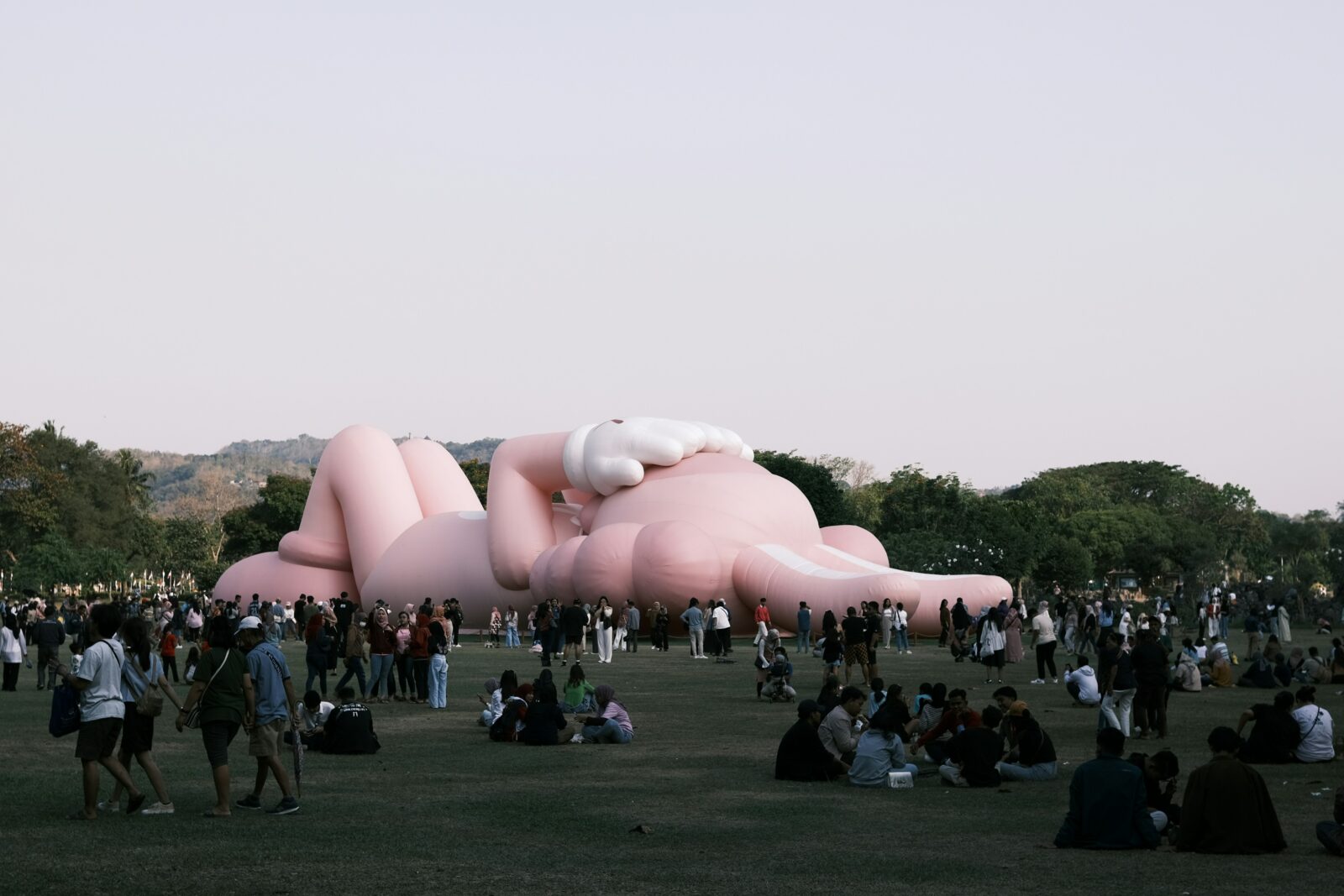
NYBG’s Living Canvas: Art and Ecology
NYBG’s program has, in recent years, consciously positioned itself at the intersection of art and ecology. The Garden has hosted blockbuster art installations that engage nature both aesthetically and intellectually. In 2021, Yayoi Kusama’s “Cosmic Nature” filled the glass conservatory with pumpkins, mirror rooms, and polka dots in wild profusion.
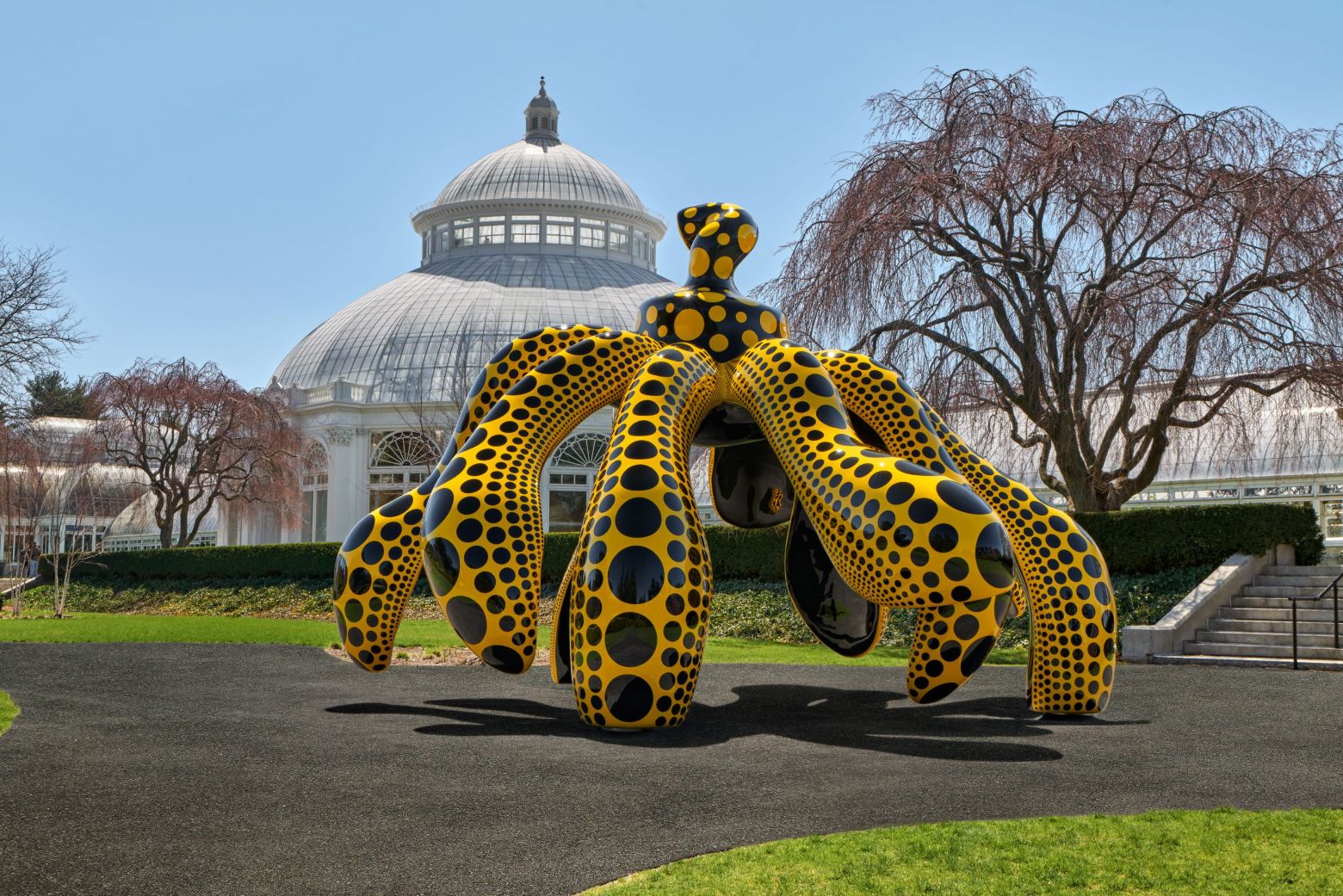
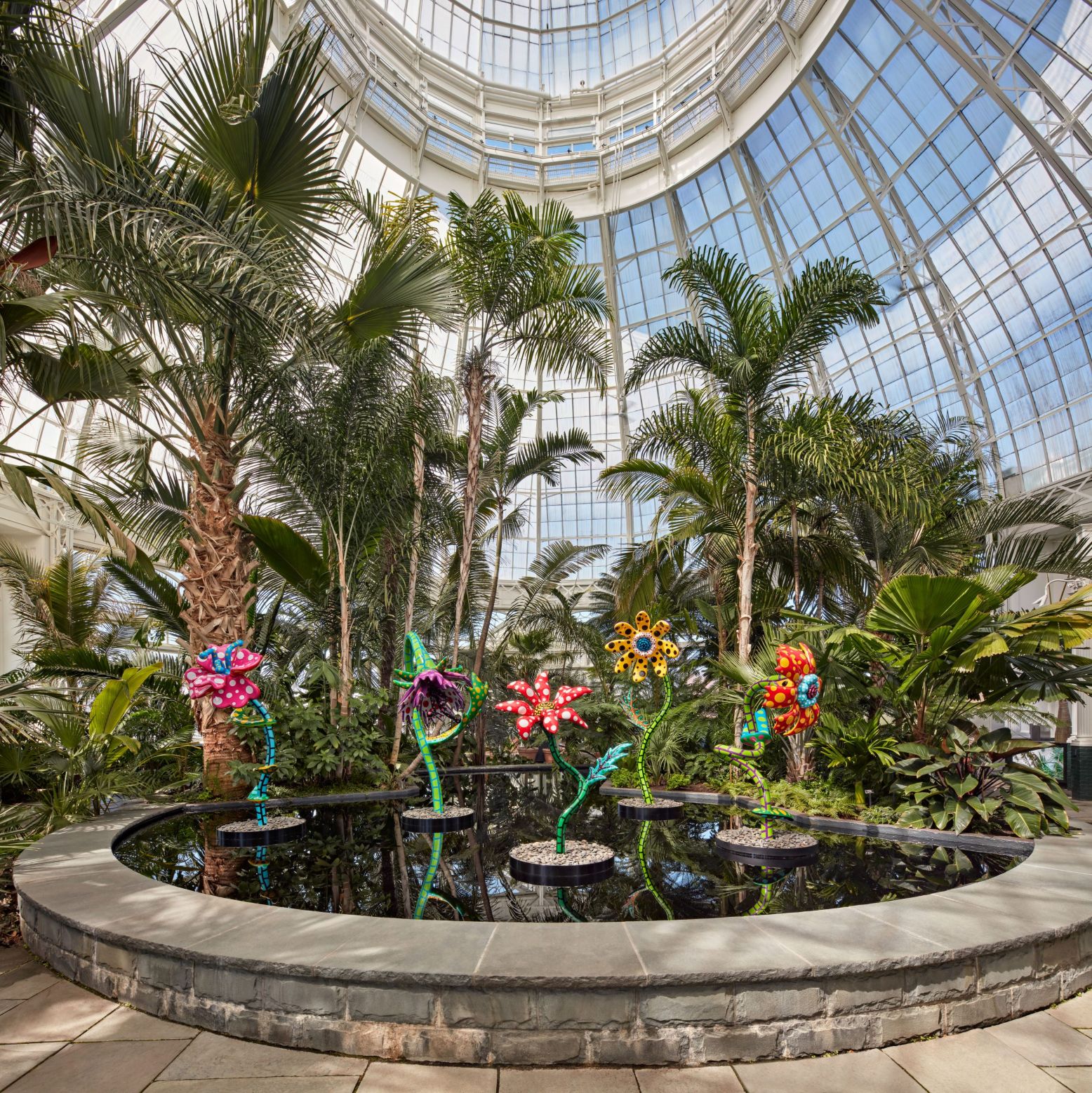
In summer 2023, Jamaican artist Ebony G. Patterson used glittering sculpted vultures descending over carved-out “wounds” in the lawn to evoke colonial histories and environmental loss in the garden’s collections. A Hyperallergic preview described Patterson’s show as “a living work of art, embracing horticulture, hidden histories, and wild, uncultivated nature.” NYBG’s leadership sees horticulture as a collaborator in storytelling. CEO Jennifer Bernstein puts it plainly: the Garden offers “our living collections as inspiration from which to create new, interdisciplinary work”, and their shows “illuminate the rich intersection of art and nature”.
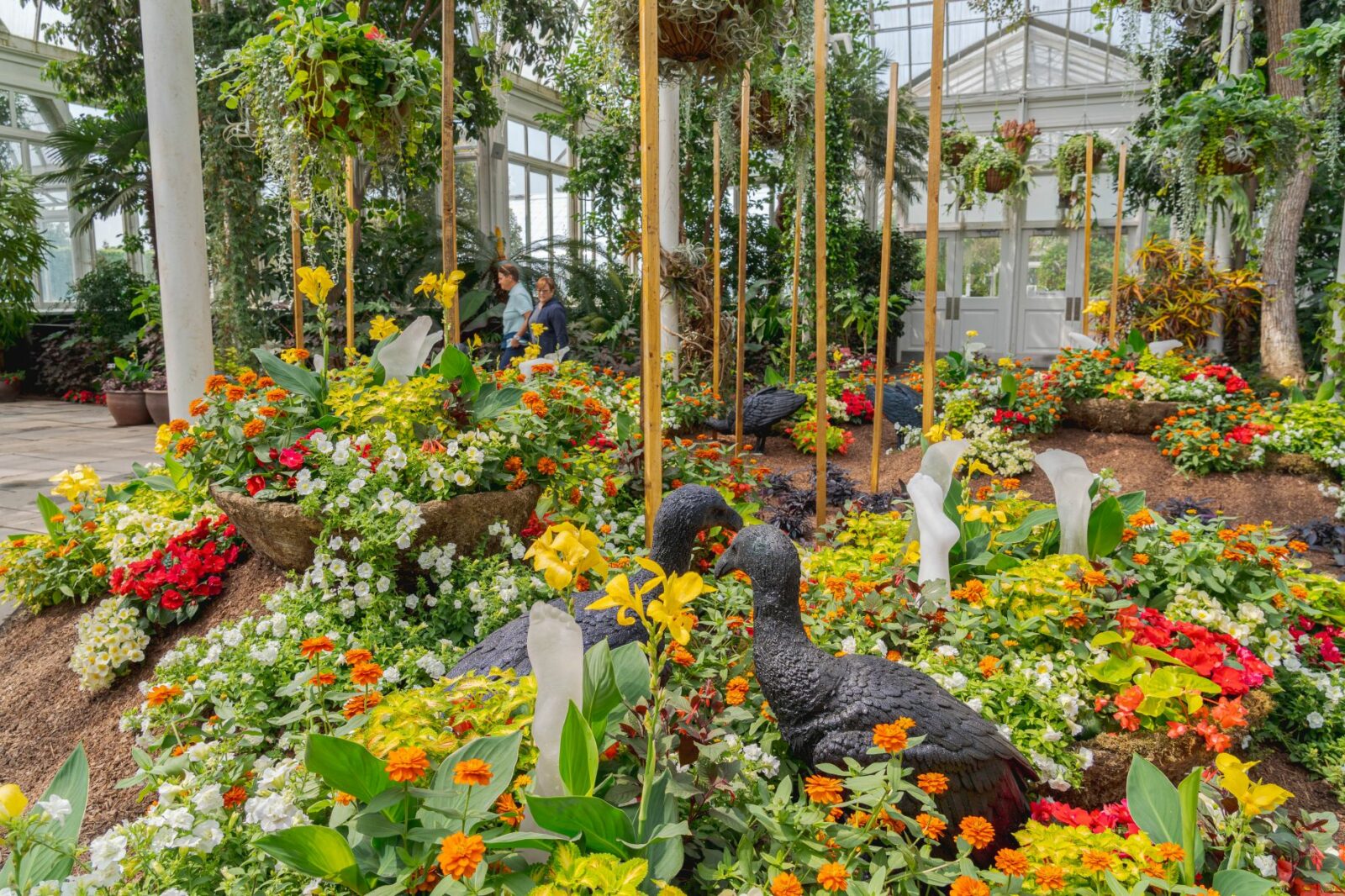
The 2026 slate deepens this strategy. The Orchid Show will be reconceived by Mr. Flower Fantastic as a “Concrete Jungle” – a tribute to New York City made entirely of orchids and blooms. A summer show called “Flower Power” will celebrate the flower’s role in 1960s peace culture with giant installations and archival graphics. These exhibitions (along with the return of NYBG’s beloved Holiday Train) are part of a two-year plan that is even being offered via new two-year memberships. Together, they underscore NYBG’s ambition to “welcome visitors to explore the joy and beauty” of plants through art. As their recent press release notes, NYBG is reflecting “the work at the intersection of ecology, design, and the arts” by collaborating with leading contemporary creators. A KAWS takeover thus slots into a larger narrative: the Garden is not just a backdrop, but a partner in creative expression.
KAWS’s Green Turn: Art among the Flowers
KAWS’s own oeuvre has rarely interacted directly with plants, so the Botanical Garden setting will be striking. Visitors can expect to “set out to find awe-inspiring scenes both inside our galleries and across our 250 acres” of green. Imagine Companion and friends peeking through groves of trees, or a colossal BENDY character striding along a riverside path. Against this backdrop, KAWS’s bright plastic-like surfaces and cartoon silhouettes will pop amid ferns and flowers, transforming greenery into a pop-art landscape.
This context invites reflection on the intersection of nature and consumer culture. KAWS’s sculptures often recall commercial merchandising as they are giant toys made manifest. Placing them amid living foliage creates a theatrical dialogue. On one hand, the garden tames and softens: towering trees dwarf the figures, and seasonal blooms could frame an installation like petals around a cartoon bud. On the other hand, the whimsical intrusion of toys into wild space makes the art feel more playful and surreal. It also underscores the path of KAWS’s career: from ad-busting on city streets to collaborating on cereal-box designs and global ad campaigns, his practice has always blurred boundaries. Now it blurs the boundary between the concrete city and the natural world.
Yet amidst the whimsy, we should not forget the weightier themes. Companion lying pensively under a magnolia tree will evoke loneliness in a communal space; a pair of figures leaning on one another by a pond might suggest solidarity in an uncertain world. The Garden’s planting philosophy already draws attention to impermanence and care (for example, by featuring endangered species and long-lived trees). KAWS’s work will add another layer: commentary on isolation and human connection. As curator Eugenie Tsai noted, KAWS’s portraits of “love, friendship, isolation, [and] loneliness” are very much of our time. In an era of urban crowds and social media, a quiet corner of the Botanical Garden where a giant Companion folds its hands might feel almost sacred.
NYBG’s experience with Ebony Patterson gives a precedent: people tend to respond emotionally when art in the garden is deeply human. Patterson’s glittering vultures and ghostly sculptures prompted visitors to contemplate extinction and the past. One can imagine KAWS’s fans, who range from design students to sneakerheads, confronting a Companion at full scale will feel similarly novel – seeing a familiar toy turned into monumental art amid real plants is a gentle shock. It punctuates city rhythms with a pause. Even a staid conservatory gallery will be recontextualized: KAWS’s “hard-edge paintings” or mural-like works could line a gallery wall inside the Haupt Conservatory (just as past shows have used that glasshouse for Kaleidoscopic flower rooms, now it might display stretched canvas or vinyl-wrapped pieces). Everywhere, a dialogue will occur: KAWS’s consumer-age cartoon against a slow-growing living world, the recyclable fiberglass sculpture amid irreproducible orchids.
NYBG invites visitors to “set out to find awe-inspiring scenes” across its grounds – a treasure hunt of art in nature. Given KAWS’s history of unexpected sitings (a camping ground under Mt. Fuji, or a rooftop in Hong Kong), one anticipates surprises: perhaps a Companion moored by a fountain, or a sculpture of Bendy nestled under an oak. These “bold interventions,” as the NYBG calls them, will shift how we view both art and the environment. Contemporary art in public has often meant museums or plazas; KAWS at NYBG suggests parks and gardens are equally fertile ground.
In recent years, KAWS has stated that he doesn’t impose meaning on his viewers; instead, he “puts [the work] into the world” and lets people respond. The Botanical Garden, with its mix of families, schoolchildren, gardeners, and Instagrammers, promises a diverse audience. Some will come for the novelty – “Did you see the big KAWS sculpture at the lilac trees?” – and leave with a photo. Others might think about the irony of consumer iconography thriving in nature’s domain. At NYBG, KAWS’s characters will not just be a brand or a spectacle, but part of a larger ecosystem of ideas. They might even underscore what the Garden teaches about care: Companion cannot tend the flowers it lies among; perhaps its stance is a mirror to our own need for connection and stewardship.
Pop Culture Takes Root
KAWS’s arrival at the New York Botanical Garden encapsulates many 21st-century paradoxes: art as both commodity and sincere expression, technology and nature, solitude and community. In a way, KAWS has always been about dualities – bright versus dark, cute versus tragic, global versus intimate. Placing his work in a garden makes those contrasts literal. Surrounded by plants that grow slowly and quietly, his towering, manufactured characters will both stand out and somehow belong.
Whether one loves Companion or thinks he’s just an oversized cartoon, this exhibition will undeniably stir conversation. It asserts that botanical spaces can host blockbuster art without compromising their mission; it demonstrates that even the most commercially driven contemporary artists can find new meaning in a green sanctuary. As visitors wander among orchids and sculptures alike, they’ll experience KAWS anew: not just as a pop artist, but as an artist in whole dialogue with nature. In that fusion of design and ecology, the NYBG 2027 exhibition promises to bloom into something both playful and profound, a garden of pop culture flourishing in the open air.





